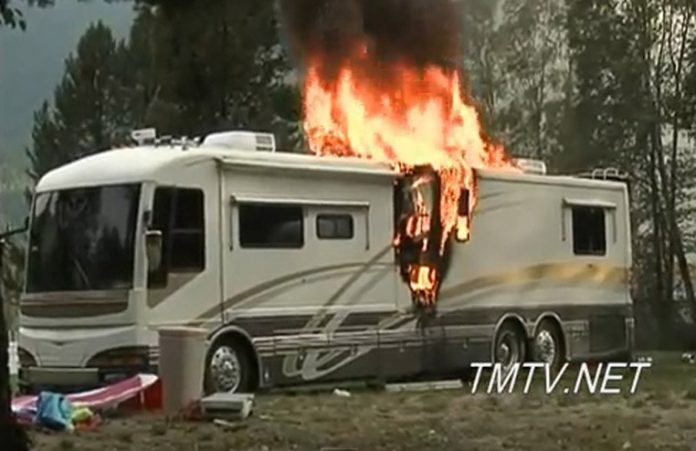It only takes a minute for an RV trip to turn into an emergency situation – now is the time to learn how your RV safety systems work!
One of my friends from Texas called me recently about a fire in a rental motorhome that occurred when the right front tire overheated from lack of air pressure and caught fire. The fire spread quickly and prevented the occupants from getting out the front entry door. They died in their RV – perhaps because they did not know about the emergency escape exit or they did not know how to open it.
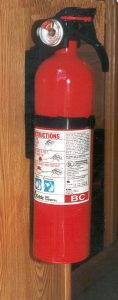 The RV safety standards stipulate that RV’s that are built for sale in Canada must “be equipped with two unobstructed ways to get to the outside”. If the entrance door is blocked for any reason, then an alternate escape route would be through an egress window in the opposite side wall near the back of the RV. Years ago, many motorhomes had a 24 inch square escape hatch in the center of the roof and a ladder to allow you to climb down to the ground. If the RV was on its side, you could stand on the sidewall and still reach the hatch to climb out to the ground. A driver’s door may be considered an alternate exit, but it may take you a few extra moments to crawl over the seat.
The RV safety standards stipulate that RV’s that are built for sale in Canada must “be equipped with two unobstructed ways to get to the outside”. If the entrance door is blocked for any reason, then an alternate escape route would be through an egress window in the opposite side wall near the back of the RV. Years ago, many motorhomes had a 24 inch square escape hatch in the center of the roof and a ladder to allow you to climb down to the ground. If the RV was on its side, you could stand on the sidewall and still reach the hatch to climb out to the ground. A driver’s door may be considered an alternate exit, but it may take you a few extra moments to crawl over the seat.
If you detect a fire in your RV, you must quickly decide whether it is small enough for you to fight. You cannot spend time looking for an extinguisher since the fire can double in size every 20 seconds – if you don’t move quickly, you may have to fight your way out..
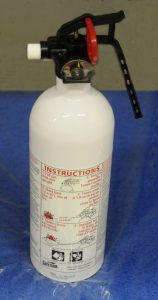 “Every recreational vehicle shall have a portable fire extinguisher that is readily accessible and located in the interior of the vehicle within 24 inches of the entry door”. It needs to have a minimum rating of 5B:C which means that it can be used on a fire of 5 square feet. Extinguishers for motorhomes must have a minimum rating of 10 B:C (ten square foot fire). Now you may think that modern technology should be able to find a solution to the problem. You could point to race cars that have automatic Halon fire extinguishers to stop an engine fire, but since the RV engine is not in an enclosed space, the Halon, which is heavier than air, would just fall out and the fire could easily restart.
“Every recreational vehicle shall have a portable fire extinguisher that is readily accessible and located in the interior of the vehicle within 24 inches of the entry door”. It needs to have a minimum rating of 5B:C which means that it can be used on a fire of 5 square feet. Extinguishers for motorhomes must have a minimum rating of 10 B:C (ten square foot fire). Now you may think that modern technology should be able to find a solution to the problem. You could point to race cars that have automatic Halon fire extinguishers to stop an engine fire, but since the RV engine is not in an enclosed space, the Halon, which is heavier than air, would just fall out and the fire could easily restart.
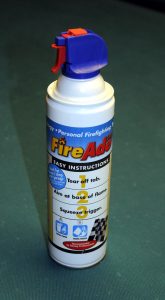 The RV industry has established guidelines for emergency exits. The latches of the escape hatch must be capable of being operated by hand from the inside with no keys or tools and the exit window must be clearly marked with the word “EXIT” in red letters. This window must be big enough for a person to climb through without squeezing. The Canadian Standards Association Z240 and the National Fire and Protection Authority 1192 codes specify that this alternative exit must be at least 24 inches wide by 17 inches high. Motorhomes and trailers are designed to have all windows open from the inside, so remember that your neighbours cannot open the safety escape hatch – only you can open it from the inside.
The RV industry has established guidelines for emergency exits. The latches of the escape hatch must be capable of being operated by hand from the inside with no keys or tools and the exit window must be clearly marked with the word “EXIT” in red letters. This window must be big enough for a person to climb through without squeezing. The Canadian Standards Association Z240 and the National Fire and Protection Authority 1192 codes specify that this alternative exit must be at least 24 inches wide by 17 inches high. Motorhomes and trailers are designed to have all windows open from the inside, so remember that your neighbours cannot open the safety escape hatch – only you can open it from the inside.
Have a Fire Drill…
When we were children, the school held fire drills on a regular basis to be sure that everyone knew what to do and where to go in the event of an emergency. This is a very important exercise for RV travellers. Have you ever opened your escape hatch to see if it works? Have you actually climbed out the window? What makes you think that you could escape through this exit if you have not mastered the technique?
In an emergency, you do not have time to find out how the hatch opens. You must practice an emergency exit from your RV and show the whole family how it is done!
You should inspect your emergency egress window on a regular basis to assure that it will work properly when necessary. You should open the escape hatch four times a year to make sure that the gaskets do not stick, and clean the gasket with a non-petroleum product like “303” (available at many RV and boat dealers). Do not use a silicon material as it attracts dust and can make the hatch harder to open.
Mac McCoy “The Fire Guy” recommends that the best method to get out is to go feet first, unless you like dropping on your head. Almost every RV that has a rear bedroom has a bed spread. Open the latches, push the window open and using a short piece of wood to prop the window up out of the way, and fold the spread over the sharp edge of the window. The spread will now act as a cushion over the edge of the window frame as you climb out feet first, face down and then drop to the ground.
You do not have time to look for your pet. No matter how much you love it, it is not worth losing your own life to save an animal. For the same reason, do not waste time looking for personal items if the RV is on fire. Many motorhome drivers place their wallet on the dash so that they do not have to sit on it. You do not have time to look around to see what you can take with you. What you are wearing is all there is. Do you have a “Get-A-Way” bag? This should contain your phone, your wallet, your purse, your passport, a credit card, a bank access card, $100 cash, and a list of prescription drugs.
DO NOT GO BACK INTO A BURNING RV. When you are out of the vehicle, get a safe distance away from the RV because fibreglass burns very hot and the smoke is more toxic than asbestos.
 Be Prepared!
Be Prepared!
If you use a computer in your RV, it is a good idea to record a USB drive with your important information including the numbers for your driver’s license, passport, credit cards, doctor, prescriptions, contacts, and bank accounts in case your wallet is ever lost. Your laptop computer may still be inside the burning motorhome. Put the USB key in your “get away bag”.
Every RV must have a battery-operated smoke detector in the kitchen, living room, or any area that has electrical equipment. It should be mounted near the ceiling since smoke rises. A propane detector should be near the floor as propane is heavier than air, and a carbon monoxide detector should be mounted about eight inches below the ceiling because carbon monoxide is lighter than air (0.9225 density). If you have a generator, it is wise to mount another carbon monoxide detector inside the RV, in the area near the location of the generator exhaust, because exhaust can creep into the RV through a slideout.
Do you have “ICE” on your cell phone?
In many jurisdictions, first responders are not allowed to open your wallet to find out any information, but they can access the information in your cellphone. The first entry on your contact list should be “In Case of Emergency” (ICE) with a contact phone number. To make sure that this is at the top of your list, enter 1CE (oneCE) and the number of your next of kin. I have five numbers- first is our house number, and then one for each of our son’s cell phones. They are listed as 1CE #1, 1CE #2, 1CE #3, 1CE #4, and 1CE #5.
In one incident that we are aware of, the driver lost power when a fire started in the rear engine compartment of the motorhome, and he pulled to the side of the road – unfortunately, he stopped too close to a guard rail and could not open the entry door to get out. Luckily, the firemen were able to break out the front window so that the RV’ers could escape with injuries limited to a case of smoke inhalation.
Causes of RV Fires
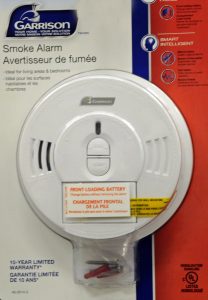 Fires in the engine compartment usually occur from fuel leaks that spray on the hot manifold pipes. When radiator hoses break, the water in the antifreeze solution can evaporate leaving pure alcohol to start a fire in the wiring. Most kitchen fires are caused by frying food in a pan on the stovetop. Throwing water on this type of fire only makes it flare up larger. It is better to cover the pan with a lid to keep oxygen away from the flames. If you have a propane fire, turn off the propane. If you have an electrical fire, turn off the electricity.
Fires in the engine compartment usually occur from fuel leaks that spray on the hot manifold pipes. When radiator hoses break, the water in the antifreeze solution can evaporate leaving pure alcohol to start a fire in the wiring. Most kitchen fires are caused by frying food in a pan on the stovetop. Throwing water on this type of fire only makes it flare up larger. It is better to cover the pan with a lid to keep oxygen away from the flames. If you have a propane fire, turn off the propane. If you have an electrical fire, turn off the electricity.
One of our friends had installed an auxiliary transmission cooler in his motorhome and the clamps were not installed properly. The escaping fluid hit the hot muffler causing it to burst into flame. Luckily, he stopped in front of the village fire department and the firefighters were able to bring it under control quickly, but not before all of the engine wiring had burned and the interior was damaged by smoke.
A man and woman with two grandchildren were badly burned at a campground recently when a propane leak exploded in their trailer. Nearby campers were able to open the door to get them out to safety. If you smell a leak inside your RV, turn off the gas valve outside, open the door and windows, do not touch any electrical switches and get out of the vehicle. Call the fire department. Since propane is heavier than air, you can often use a broom to sweep out any propane that has settled on the floor or inside the kitchen cabinets.
Sometimes, a zealous propane attendant will overfill your tanks. On a hot day, the sun shining on the tanks will cause the propane to expand and force the relief valve to open. If this happens, spray cold water from a hose onto the tanks to cool them off.
You must practice getting out of your RV when there is no emergency and you can take your time. RV safety is extremely important and understanding how to react during an emergency situation can be the difference between life and death.


















